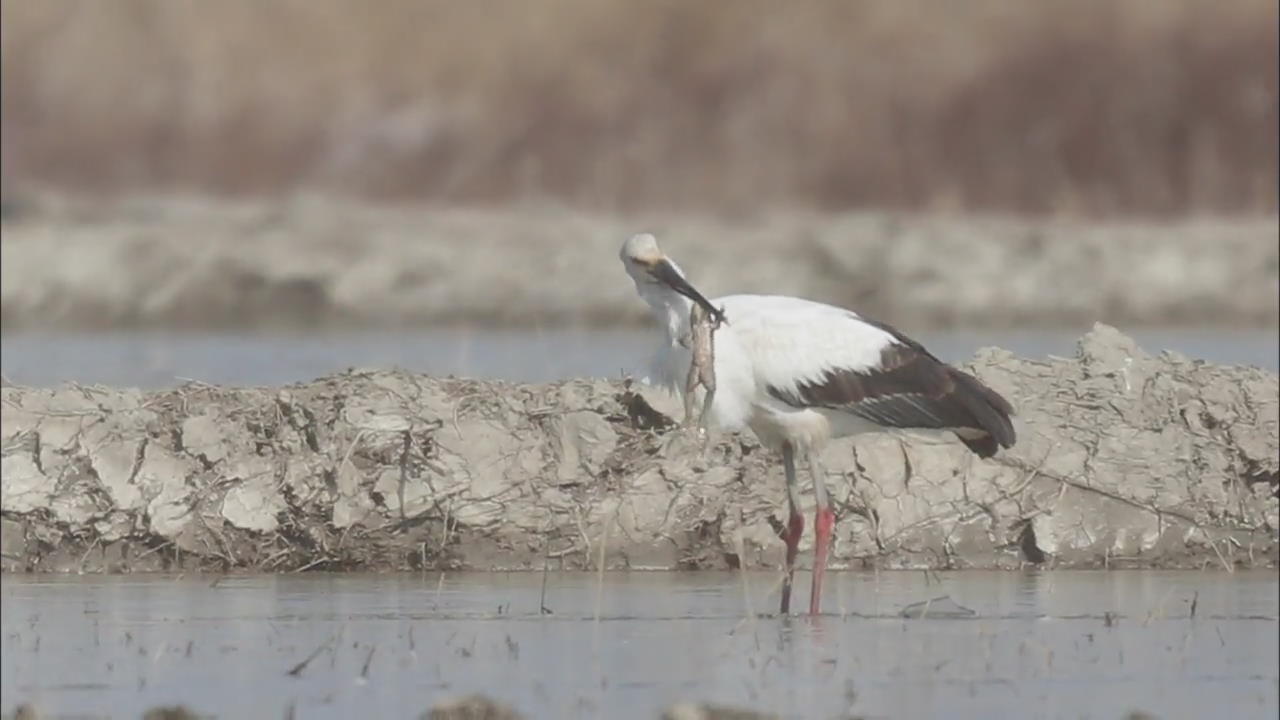Bird Protection
입력 2019.03.05 (15:20)
수정 2019.03.05 (15:35)
읽어주기 기능은 크롬기반의
브라우저에서만 사용하실 수 있습니다.
[Anchor Lead]
Efforts to restore white storks, a natural monument in Korea, will likely gain pace as white storks that have arrived in Korea from Russia and Japan are frequently being spotted together with birds that have been released to the wild in Korea. The efforts have been lauded for their success in the restoration of the species in East Asia.
[Pkg]
A white stork gobbles down its prey, a bullfrog, in the blink of an eye. Other birds chase each other to snatch away their prey. In a rare instance, 12 white storks including those that have flown from Russia in search of a warmer climate and those that were released to the wild in Korea have been spotted together.
[Soundbite] Oh Young-sang(Ecologist) : "The birds are moving southward because they cannot find food in northern regions, where water is frozen."
A flock of white storks was also spotted in a snow-covered wetland. The birds search for prey, moving slowly. One of them is a white stork marked 'A81'. It came from North Korea after spending 71 days there.
[Soundbite] Kim Dong-hyun(Birdwatcher) : "If white storks can find a lot of food and be healthy here, the A81 may even fly over to Japan."
Last winter, white storks were spotted more frequently than ever in various regions of Korea. Forty-four white storks were seen in about ten areas. Most of them were from Russia.
[Soundbite] Prof. Park Si-ryong(Korea National University of Education) : "If the birds that came from Russia do not return and instead mate with local birds, the genetic diversity of this species will improve further."
With more white storks spending winter on the Korean Peninsula, the efforts to restore the species have a higher chance of succeeding.
Efforts to restore white storks, a natural monument in Korea, will likely gain pace as white storks that have arrived in Korea from Russia and Japan are frequently being spotted together with birds that have been released to the wild in Korea. The efforts have been lauded for their success in the restoration of the species in East Asia.
[Pkg]
A white stork gobbles down its prey, a bullfrog, in the blink of an eye. Other birds chase each other to snatch away their prey. In a rare instance, 12 white storks including those that have flown from Russia in search of a warmer climate and those that were released to the wild in Korea have been spotted together.
[Soundbite] Oh Young-sang(Ecologist) : "The birds are moving southward because they cannot find food in northern regions, where water is frozen."
A flock of white storks was also spotted in a snow-covered wetland. The birds search for prey, moving slowly. One of them is a white stork marked 'A81'. It came from North Korea after spending 71 days there.
[Soundbite] Kim Dong-hyun(Birdwatcher) : "If white storks can find a lot of food and be healthy here, the A81 may even fly over to Japan."
Last winter, white storks were spotted more frequently than ever in various regions of Korea. Forty-four white storks were seen in about ten areas. Most of them were from Russia.
[Soundbite] Prof. Park Si-ryong(Korea National University of Education) : "If the birds that came from Russia do not return and instead mate with local birds, the genetic diversity of this species will improve further."
With more white storks spending winter on the Korean Peninsula, the efforts to restore the species have a higher chance of succeeding.
■ 제보하기
▷ 카카오톡 : 'KBS제보' 검색, 채널 추가
▷ 전화 : 02-781-1234, 4444
▷ 이메일 : kbs1234@kbs.co.kr
▷ 유튜브, 네이버, 카카오에서도 KBS뉴스를 구독해주세요!
- Bird Protection
-
- 입력 2019-03-05 15:23:20
- 수정2019-03-05 15:35:18

[Anchor Lead]
Efforts to restore white storks, a natural monument in Korea, will likely gain pace as white storks that have arrived in Korea from Russia and Japan are frequently being spotted together with birds that have been released to the wild in Korea. The efforts have been lauded for their success in the restoration of the species in East Asia.
[Pkg]
A white stork gobbles down its prey, a bullfrog, in the blink of an eye. Other birds chase each other to snatch away their prey. In a rare instance, 12 white storks including those that have flown from Russia in search of a warmer climate and those that were released to the wild in Korea have been spotted together.
[Soundbite] Oh Young-sang(Ecologist) : "The birds are moving southward because they cannot find food in northern regions, where water is frozen."
A flock of white storks was also spotted in a snow-covered wetland. The birds search for prey, moving slowly. One of them is a white stork marked 'A81'. It came from North Korea after spending 71 days there.
[Soundbite] Kim Dong-hyun(Birdwatcher) : "If white storks can find a lot of food and be healthy here, the A81 may even fly over to Japan."
Last winter, white storks were spotted more frequently than ever in various regions of Korea. Forty-four white storks were seen in about ten areas. Most of them were from Russia.
[Soundbite] Prof. Park Si-ryong(Korea National University of Education) : "If the birds that came from Russia do not return and instead mate with local birds, the genetic diversity of this species will improve further."
With more white storks spending winter on the Korean Peninsula, the efforts to restore the species have a higher chance of succeeding.
Efforts to restore white storks, a natural monument in Korea, will likely gain pace as white storks that have arrived in Korea from Russia and Japan are frequently being spotted together with birds that have been released to the wild in Korea. The efforts have been lauded for their success in the restoration of the species in East Asia.
[Pkg]
A white stork gobbles down its prey, a bullfrog, in the blink of an eye. Other birds chase each other to snatch away their prey. In a rare instance, 12 white storks including those that have flown from Russia in search of a warmer climate and those that were released to the wild in Korea have been spotted together.
[Soundbite] Oh Young-sang(Ecologist) : "The birds are moving southward because they cannot find food in northern regions, where water is frozen."
A flock of white storks was also spotted in a snow-covered wetland. The birds search for prey, moving slowly. One of them is a white stork marked 'A81'. It came from North Korea after spending 71 days there.
[Soundbite] Kim Dong-hyun(Birdwatcher) : "If white storks can find a lot of food and be healthy here, the A81 may even fly over to Japan."
Last winter, white storks were spotted more frequently than ever in various regions of Korea. Forty-four white storks were seen in about ten areas. Most of them were from Russia.
[Soundbite] Prof. Park Si-ryong(Korea National University of Education) : "If the birds that came from Russia do not return and instead mate with local birds, the genetic diversity of this species will improve further."
With more white storks spending winter on the Korean Peninsula, the efforts to restore the species have a higher chance of succeeding.
이 기사가 좋으셨다면
-
좋아요
0
-
응원해요
0
-
후속 원해요
0














![[단독] 김민석 총리, 취임 첫 일정으로 ‘송미령 반대’ 농민단체 농성장 방문](/data/news/2025/07/03/20250703_YUTdgQ.png)
![[단독] ‘스테로이드’부터 ‘임신중지약’까지…해외 의약품 불법 유통 11만 건](/data/news/2025/07/03/20250703_qpUU1y.png)

이 기사에 대한 의견을 남겨주세요.